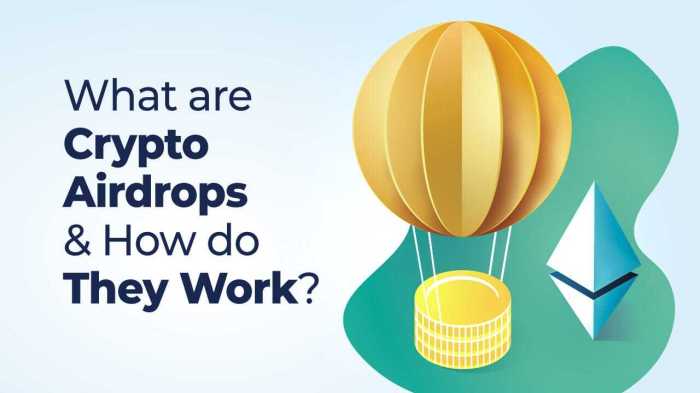How to identify legitimate Bitcoin airdrop opportunities is a crucial skill for navigating the volatile cryptocurrency landscape. The allure of free Bitcoin often masks sophisticated scams, leaving unsuspecting investors vulnerable to significant losses. This guide provides essential strategies to differentiate genuine airdrops from fraudulent schemes, empowering users to participate safely and confidently in this potentially lucrative space.
Understanding the mechanics of legitimate airdrops, verifying the authenticity of promoters, and recognizing red flags are key components of this process. By employing careful due diligence and utilizing the resources and checklists provided, individuals can significantly reduce their risk of falling prey to deceptive airdrop offers and protect their digital assets.
Recognizing Red Flags in Bitcoin Airdrop Offers: How To Identify Legitimate Bitcoin Airdrop Opportunities

The allure of free Bitcoin through airdrops is undeniable, but navigating this space requires caution. Many fraudulent schemes masquerade as legitimate opportunities, preying on unsuspecting users. Understanding the common tactics employed by scammers is crucial to protecting your digital assets. This section details key red flags to watch out for when evaluating potential Bitcoin airdrop offers.Deceptive Tactics in Fraudulent Airdrop SchemesFraudulent airdrop schemes often employ a range of deceptive tactics to lure victims.
These tactics can range from sophisticated phishing campaigns to outright scams involving fake websites and social media accounts. One common tactic is the promise of exceptionally high returns with minimal effort, often far exceeding realistic market expectations. Another involves creating a sense of urgency, pressuring users to act quickly before the “opportunity” disappears. These tactics exploit human psychology, leveraging greed and fear to manipulate individuals into participating.Comparing Legitimate and Suspicious Airdrop AnnouncementsLegitimate airdrop announcements from established projects typically follow a clear and transparent process.
They often involve partnerships with reputable exchanges or platforms, providing a degree of verification. The announcement itself will usually be made through official project channels, such as the project’s website or verified social media accounts. In contrast, suspicious announcements frequently lack this transparency, appearing on less reputable platforms or using unofficial communication channels. They often lack concrete details about the airdrop process and lack verifiable information regarding the project’s team and history.Verifying Project AuthenticityVerifying the authenticity of a project is paramount before participating in any airdrop.
This involves thoroughly investigating the project’s website and social media presence. Look for a clearly defined project roadmap, a transparent team structure with publicly available information about the team members, and evidence of previous successful projects or community engagement. Cross-referencing information across multiple platforms is crucial to verify the consistency of the information provided. A lack of transparency or inconsistencies should raise immediate concerns.
Comparison of Legitimate vs. Illegitimate Airdrop Announcements, How to identify legitimate Bitcoin airdrop opportunities
| Project Name | Source | Verification Methods | Red Flags |
|---|---|---|---|
| Example Legitimate Project (e.g., established DeFi protocol) | Official website, verified Twitter account, announcements on reputable crypto news sites | Check website domain age and security, verify Twitter account’s authenticity, cross-reference information across multiple sources | None; clear terms and conditions, transparent process, verifiable team |
| Example Suspicious Project (e.g., unknown token with unrealistic promises) | Unverified Telegram group, generic website, unsolicited email | Website lacks detailed information, no verifiable team information, no credible news coverage | Unrealistic promises of high returns, pressure to act quickly, anonymous team, lack of transparency, suspicious website design |
Verifying the Authenticity of Bitcoin Airdrop Promoters
Navigating the world of Bitcoin airdrops requires a discerning eye. While legitimate opportunities exist, many scams prey on unsuspecting users. Therefore, rigorously verifying the authenticity of the entities promoting these airdrops is crucial to avoid financial losses. This involves examining various aspects of the promoter’s online presence and history.The legitimacy of a Bitcoin airdrop promoter can be assessed through several key methods.
Understanding these methods empowers users to make informed decisions and protect their digital assets. Failing to conduct thorough due diligence can lead to irreversible financial losses.
Examining Promoter Track Record
Determining the legitimacy of a Bitcoin airdrop promoter often hinges on their past performance. A proven track record of successful, legitimate airdrops significantly increases credibility. Investigating the promoter’s history involves searching for verifiable information about previous airdrops they’ve conducted. This might involve checking reputable cryptocurrency news sites, forums, and blockchain explorers to confirm the distribution of tokens and the overall success of past events.
For example, if a promoter claims to have conducted a previous airdrop, one could verify this claim by searching for news articles covering the event or by checking the blockchain to see if the promised tokens were actually distributed. Absence of such evidence should raise serious red flags.
Identifying and Avoiding Fake Social Media Accounts and Websites
The digital landscape is rife with fraudulent accounts and websites designed to mimic legitimate airdrop promoters. Identifying these fakes requires a multi-pronged approach. Firstly, carefully examine the social media account’s age and activity. Newly created accounts with minimal engagement are highly suspicious. Secondly, look for inconsistencies in branding and messaging across different platforms.
Legitimate promoters usually maintain a consistent brand identity across all their online channels. Thirdly, be wary of accounts with an unusually high number of followers but limited engagement. Finally, always check the website’s URL for any typos or inconsistencies. Legitimate promoters typically use secure and verified websites. For instance, a website with a URL containing numerous misspellings or an unusual domain extension (e.g., .tk instead of .com) should be treated with extreme caution.
Similarly, social media accounts with drastically inflated follower counts compared to their engagement levels (likes, comments, shares) should be considered suspicious.
Checklist for Verifying the Authenticity of a Bitcoin Airdrop Promoter
Before participating in any Bitcoin airdrop, it’s crucial to conduct a thorough verification process. This checklist provides a structured approach to assess the promoter’s legitimacy:
- Verify the Promoter’s Online Presence: Check for consistent branding and messaging across multiple platforms (website, social media, etc.).
- Investigate Past Airdrops: Search for verifiable evidence of previous successful airdrops conducted by the promoter. Use reputable cryptocurrency news sources and blockchain explorers.
- Analyze Social Media Accounts: Assess the account’s age, activity, follower count, and engagement levels. Be wary of inconsistencies and inflated metrics.
- Examine the Website’s Security: Check the website’s URL for typos, unusual domain extensions, and the presence of an SSL certificate (HTTPS).
- Review Community Feedback: Search for community discussions and reviews about the promoter on reputable forums and cryptocurrency communities.
- Look for Whitepaper or Detailed Information: A legitimate airdrop will usually have a whitepaper or detailed information about the project and the airdrop process itself.
- Avoid Promises of Guaranteed Returns: Legitimate airdrops do not guarantee high returns or profits. Be wary of overly optimistic claims.
Understanding the Mechanics of Legitimate Airdrops

Legitimate Bitcoin airdrops, unlike fraudulent schemes, are carefully orchestrated events by cryptocurrency projects aiming to increase brand awareness and distribute their tokens. Understanding the mechanics of these events is crucial for safe participation and avoiding scams. This section details the process, security measures, and different types of legitimate airdrops.A legitimate airdrop involves a project distributing its cryptocurrency tokens or coins to a pre-defined group of users, often as a reward for participation in a specific activity or for holding a related cryptocurrency.
Eligibility criteria are clearly defined, distribution is transparent, and reputable projects employ rigorous security measures to prevent manipulation.
Eligibility Criteria and Distribution Methods
Eligibility criteria for legitimate airdrops vary. Some airdrops might require users to hold a specific cryptocurrency, participate in social media campaigns, complete surveys, or engage in other activities that benefit the project. Distribution methods often involve smart contracts that automatically transfer tokens to eligible addresses. This automated process ensures fairness and prevents manual manipulation. Projects may use various platforms for distribution, including their own websites, dedicated airdrop platforms, or even directly through exchanges.
Transparency is key; legitimate airdrops will clearly Artikel the criteria and methods.
Security Measures in Legitimate Airdrops
Reputable projects employ various security measures to protect against fraud and manipulation. These measures include using secure smart contracts audited by independent security firms to verify the code’s integrity and prevent vulnerabilities. They also often utilize cryptographic techniques to ensure the fair and tamper-proof distribution of tokens. Transparency in the airdrop process, including clearly stated eligibility rules and a publicly auditable distribution mechanism, is a critical security feature.
Additionally, many projects will publicize the total number of tokens being distributed, preventing the artificial inflation of the token supply.
Types of Bitcoin Airdrops and Associated Risks
Several types of airdrops exist, each with its own level of risk. Snapshot airdrops distribute tokens based on a snapshot of blockchain data at a specific point in time. Holders of a particular cryptocurrency at that moment receive a proportional share of the airdropped tokens. The risk here lies primarily in the project’s legitimacy; a rug pull after the snapshot could render the airdrop worthless.
Holder airdrops are similar but may require users to hold the token for a specific duration. Bounty airdrops reward users for completing tasks such as retweeting, joining Telegram channels, or referring new users. These carry a higher risk of being associated with low-quality projects or scams, as participation doesn’t necessarily require holding any cryptocurrency.
Step-by-Step Guide for Safe Airdrop Participation
Participating in Bitcoin airdrops requires caution. Here’s a step-by-step guide to mitigate risks:
- Thoroughly Research the Project: Investigate the project’s website, whitepaper, team, and community engagement. Look for red flags like vague information, anonymous team members, or unrealistic promises.
- Verify the Airdrop’s Legitimacy: Check multiple independent sources to confirm the airdrop’s authenticity. Avoid airdrops promoted only through unsolicited messages or suspicious websites.
- Understand the Eligibility Criteria: Carefully read the airdrop’s terms and conditions to understand the requirements and ensure you meet them.
- Use a Secure Wallet: Store your cryptocurrency in a secure, hardware wallet if possible. Avoid using exchanges or online wallets unless absolutely necessary.
- Never Share Your Private Keys: Legitimate airdrops will never request your private keys. Anyone asking for them is attempting a scam.
- Monitor the Airdrop Process: Track the airdrop’s progress through official channels and community forums. Be wary of unexpected delays or changes.
- Diversify Your Portfolio: Don’t invest more than you can afford to lose. Treat airdrops as a potential bonus, not a guaranteed profit.
Conclusive Thoughts
Successfully navigating the world of Bitcoin airdrops requires vigilance and a proactive approach to risk mitigation. By implementing the strategies Artikeld—from scrutinizing project websites and social media presence to verifying promoters and understanding the mechanics of legitimate airdrops—investors can significantly increase their chances of participating in genuine opportunities while avoiding costly scams. Remember, the promise of easy riches often hides significant risks; thorough due diligence is paramount in the cryptocurrency realm.
Question Bank
What are the common types of Bitcoin airdrop scams?
Common scams include fake social media accounts promising airdrops, phishing websites mimicking legitimate projects, and deceptive promotions requiring upfront payments or private key disclosures.
How can I report a suspected Bitcoin airdrop scam?
Report suspected scams to relevant authorities, including your local law enforcement and the cryptocurrency exchange where you may have encountered the scam. Also, report the scam to the project’s official channels (if identifiable) and on relevant online forums.
Is it safe to participate in any airdrop?
No. Only participate in airdrops from reputable projects with verifiable histories and transparent processes. Always exercise caution and conduct thorough due diligence before engaging.
What should I do if I think I’ve been scammed?
Immediately secure your accounts, change passwords, and contact your cryptocurrency exchange and relevant authorities. Document all interactions and evidence of the scam.